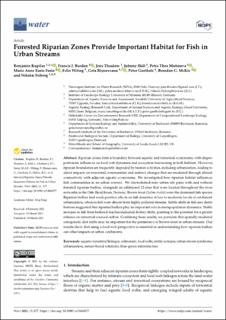| dc.contributor.author | Kupilas, Benjamin | |
| dc.contributor.author | Burdon, Francis J. | |
| dc.contributor.author | Thaulow, Jens | |
| dc.contributor.author | Håll, Johnny | |
| dc.contributor.author | Mutinova, Petra Thea | |
| dc.contributor.author | Forio, Marie Anne Eurie | |
| dc.contributor.author | Witing, Felix | |
| dc.contributor.author | Rîșnoveanu, Geta | |
| dc.contributor.author | Goethals, Peter | |
| dc.contributor.author | McKie, Brendan G. | |
| dc.contributor.author | Friberg, Nikolai | |
| dc.date.accessioned | 2021-09-10T11:27:52Z | |
| dc.date.available | 2021-09-10T11:27:52Z | |
| dc.date.created | 2021-09-07T11:02:04Z | |
| dc.date.issued | 2021 | |
| dc.identifier.citation | Water. 2021, 13 (6), 877. | en_US |
| dc.identifier.issn | 2073-4441 | |
| dc.identifier.uri | https://hdl.handle.net/11250/2775222 | |
| dc.description.abstract | Riparian zones form a boundary between aquatic and terrestrial ecosystems, with disproportionate influences on food web dynamics and ecosystem functioning in both habitats. However, riparian boundaries are frequently degraded by human activities, including urbanization, leading to direct impacts on terrestrial communities and indirect changes that are mediated through altered connectivity with adjacent aquatic ecosystems. We investigated how riparian habitat influences fish communities in an urban context. We electrofished nine urban site pairs with and without forested riparian buffers, alongside an additional 12 sites that were located throughout the river networks in the Oslo Fjord basin, Norway. Brown trout (Salmo trutta) were the dominant fish species. Riparian buffers had weak positive effects on fish densities at low to moderate levels of catchment urbanization, whereas fish were absent from highly polluted streams. Subtle shifts in fish size distributions suggested that riparian buffers play an important role in metapopulation dynamics. Stable isotopes in fish from buffered reaches indicated dietary shifts, pointing to the potential for a greater reliance on terrestrial-sourced carbon. Combining these results, we postulate that spatially-mediated ontogenetic diet shifts may be important for the persistence of brown trout in urban streams. Our results show that using a food web perspective is essential in understanding how riparian buffers can offset impacts in urban catchments. | en_US |
| dc.language.iso | eng | en_US |
| dc.publisher | MDPI | en_US |
| dc.rights | Navngivelse 4.0 Internasjonal | * |
| dc.rights.uri | http://creativecommons.org/licenses/by/4.0/deed.no | * |
| dc.title | Forested Riparian Zones Provide Important Habitat for Fish in Urban Streams | en_US |
| dc.type | Peer reviewed | en_US |
| dc.type | Journal article | en_US |
| dc.description.version | publishedVersion | en_US |
| dc.source.pagenumber | 19 | en_US |
| dc.source.volume | 13 | en_US |
| dc.source.journal | Water | en_US |
| dc.source.issue | 6 | en_US |
| dc.identifier.doi | 10.3390/w13060877 | |
| dc.identifier.cristin | 1931909 | |
| dc.relation.project | Norges forskningsråd: 264499 | en_US |
| dc.source.articlenumber | 877 | en_US |
| cristin.ispublished | true | |
| cristin.fulltext | original | |
| cristin.qualitycode | 1 | |

